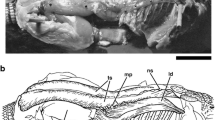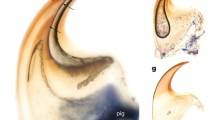Abstract
Homologies of the adductor mandibulae muscles in eight families of Tetraodontiformes were hypothesized from the branching patterns of ramus mandibularis trigeminus. Insertions of the muscles to the upper or lower jaw were weak indicators of homology, migrations of the sites occurring frequently in A1, A2α, A2β, and A3. In monacanthids, tetraodontids, and diodontids, A1 tended to be split into numerous subsections, whereas in aracanids and ostraciids, A3 was highly developed, comprising three or four subsections. In tetraodontids, A2β was found to be a composite of A1 subsection and A2β. The methods of and limits to applying nerve branching patterns to muscle homology are discussed. A new naming system that reflects both muscle homologies and insertions is proposed.
Similar content being viewed by others

Author information
Authors and Affiliations
Corresponding author
About this article
Cite this article
Nakae, M., Sasaki, K. Homologies of the adductor mandibulae muscles in Tetraodontiformes as indicated by nerve branching patterns. Ichthyol Res 51, 327–336 (2004). https://doi.org/10.1007/s10228-004-0238-2
Received:
Accepted:
Issue Date:
DOI: https://doi.org/10.1007/s10228-004-0238-2



